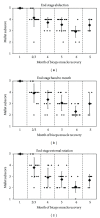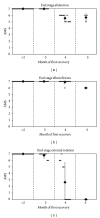The evidence for nerve repair in obstetric brachial plexus palsy revisited
- PMID: 24551845
- PMCID: PMC3914347
- DOI: 10.1155/2014/434619
The evidence for nerve repair in obstetric brachial plexus palsy revisited
Abstract
Strong scientific validation for nerve reconstructive surgery in infants with Obstetric Brachial Plexus Palsy is lacking, as no randomized trial comparing surgical reconstruction versus conservative treatment has been performed. A systematic review of the literature was performed to identify studies that compare nerve reconstruction to conservative treatment, including neurolysis. Nine papers were identified that directly compared the two treatment modalities. Eight of these were classified as level 4 evidence and one as level 5 evidence. All nine papers were evaluated in detail to describe strong and weak points in the methodology, and the outcomes from all studies were presented. Pooling of data was not possible due to differences in patient selection for surgery and outcome measures. The general consensus is that nerve reconstruction is indicated when the result of nerve surgery is assumedly better than the expected natural recovery, when spontaneous recovery is absent or severely delayed. The papers differed in methodology on how the cut-off point to select infants for nerve reconstructive surgical therapy should be determined. The justification for nerve reconstruction is further discussed.
Figures










Similar articles
-
Evidence that nerve surgery improves functional outcome for obstetric brachial plexus injury.J Hand Surg Eur Vol. 2021 Mar;46(3):229-236. doi: 10.1177/1753193420934676. Epub 2020 Jun 26. J Hand Surg Eur Vol. 2021. PMID: 32588706 Free PMC article. Review.
-
[Surgery of post-traumatic brachial plexus lesions (personal approach in 2003)].Handchir Mikrochir Plast Chir. 2004 Feb;36(1):29-36. doi: 10.1055/s-2004-817832. Handchir Mikrochir Plast Chir. 2004. PMID: 15083388 German.
-
Use of long autologous nerve grafts in brachial plexus reconstruction: factors that affect the outcome.Acta Neurochir (Wien). 2011 Nov;153(11):2231-40. doi: 10.1007/s00701-011-1131-1. Epub 2011 Aug 25. Acta Neurochir (Wien). 2011. PMID: 21866328
-
Long-Term Outcomes of Brachial Plexus Reconstruction with Sural Nerve Autograft for Brachial Plexus Birth Injury.Plast Reconstr Surg. 2019 May;143(5):1017e-1026e. doi: 10.1097/PRS.0000000000005557. Plast Reconstr Surg. 2019. PMID: 31033825
-
Perinatal brachial plexus palsy.Curr Opin Pediatr. 2000 Feb;12(1):40-7. doi: 10.1097/00008480-200002000-00009. Curr Opin Pediatr. 2000. PMID: 10676773 Review.
Cited by
-
Obstetric brachial plexus palsy: reviewing the literature comparing the results of primary versus secondary surgery.Childs Nerv Syst. 2016 Mar;32(3):415-25. doi: 10.1007/s00381-015-2971-4. Epub 2015 Nov 28. Childs Nerv Syst. 2016. PMID: 26615411 Review.
-
Distal nerve transfer versus supraclavicular nerve grafting: comparison of elbow flexion outcome in neonatal brachial plexus palsy with C5-C7 involvement.Childs Nerv Syst. 2017 Sep;33(9):1571-1574. doi: 10.1007/s00381-017-3492-0. Epub 2017 Jun 24. Childs Nerv Syst. 2017. PMID: 28647810
-
Oberlin's procedure in children with obstetric brachial plexus palsy.Childs Nerv Syst. 2016 Jun;32(6):1085-91. doi: 10.1007/s00381-015-3007-9. Epub 2016 Jan 13. Childs Nerv Syst. 2016. PMID: 26759018
-
Obstetric brachial plexus injury. Knowledge among health care providers in Saudi Arabia.Saudi Med J. 2017 Jul;38(7):721-726. doi: 10.15537/smj.2017.7.17615. Saudi Med J. 2017. PMID: 28674717 Free PMC article.
-
Outcome assessment for Brachial Plexus birth injury. Results from the iPluto world-wide consensus survey.J Orthop Res. 2018 Sep;36(9):2533-2541. doi: 10.1002/jor.23901. Epub 2018 Apr 24. J Orthop Res. 2018. PMID: 29566312 Free PMC article.
References
-
- McNeely PD, Drake JM. A systematic review of brachial plexus surgery for birth-related brachial plexus injury. Pediatric Neurosurgery. 2003;38(2):57–62. - PubMed
-
- Bodensteiner JB, Rich KM, Landau WM. Early infantile surgery for birth-related brachial plexus injuries: justification requires a prospective controlled study. Journal of Child Neurology. 1994;9(2):109–110. - PubMed
-
- Boome RS, Kaye JC. Obstetric traction injuries of the brachial plexus. Natural history, indications for surgical repair and results. Journal of Bone and Joint Surgery B. 1988;70(4):571–576. - PubMed
-
- Malessy MJA, Pondaag W, van Dijk JG. Electromyography, nerve action potential, and compound motor action potentials in obstetric brachial plexus lesions: validation in the absence of a ‘gold standard’. Neurosurgery. 2009;65(4):A153–A159. - PubMed
-
- Oxford Centre for Evidence-based Medicine Levels of Evidence. 2009, 2009, http://www.cebm.net/
MeSH terms
LinkOut - more resources
Full Text Sources
Other Literature Sources
Medical

